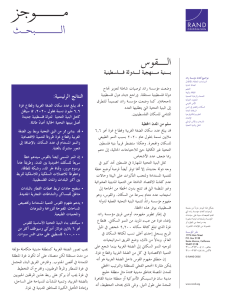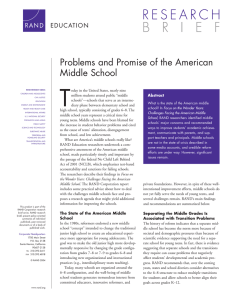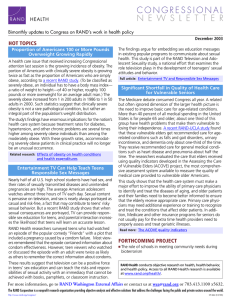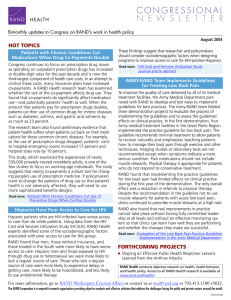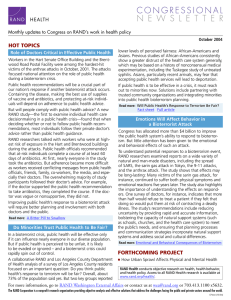April 2004
advertisement
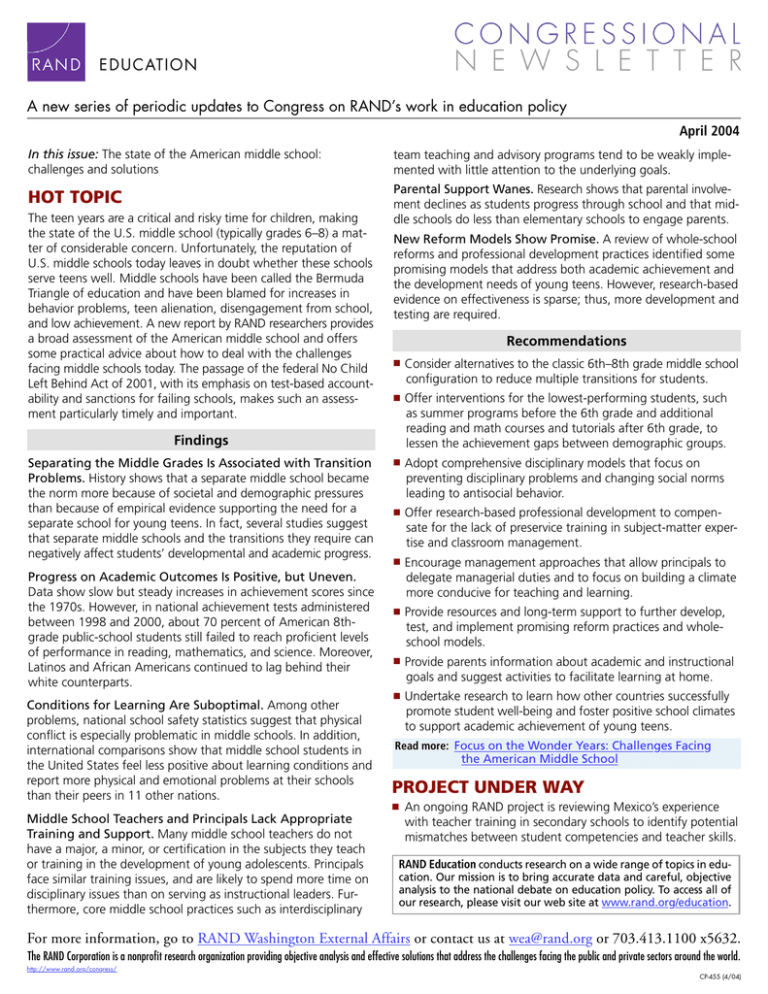
A new series of periodic updates to Congress on RAND’s work in education policy April 2004 In this issue: The state of the American middle school: challenges and solutions team teaching and advisory programs tend to be weakly implemented with little attention to the underlying goals. HOT TOPIC Parental Support Wanes. Research shows that parental involvement declines as students progress through school and that middle schools do less than elementary schools to engage parents. The teen years are a critical and risky time for children, making the state of the U.S. middle school (typically grades 6–8) a matter of considerable concern. Unfortunately, the reputation of U.S. middle schools today leaves in doubt whether these schools serve teens well. Middle schools have been called the Bermuda Triangle of education and have been blamed for increases in behavior problems, teen alienation, disengagement from school, and low achievement. A new report by RAND researchers provides a broad assessment of the American middle school and offers some practical advice about how to deal with the challenges facing middle schools today. The passage of the federal No Child Left Behind Act of 2001, with its emphasis on test-based accountability and sanctions for failing schools, makes such an assessment particularly timely and important. New Reform Models Show Promise. A review of whole-school reforms and professional development practices identified some promising models that address both academic achievement and the development needs of young teens. However, research-based evidence on effectiveness is sparse; thus, more development and testing are required. Recommendations ■ Consider alternatives to the classic 6th–8th grade middle school configuration to reduce multiple transitions for students. ■ Offer interventions for the lowest-performing students, such as summer programs before the 6th grade and additional reading and math courses and tutorials after 6th grade, to lessen the achievement gaps between demographic groups. ■ Adopt comprehensive disciplinary models that focus on preventing disciplinary problems and changing social norms leading to antisocial behavior. ■ Offer research-based professional development to compensate for the lack of preservice training in subject-matter expertise and classroom management. ■ Encourage management approaches that allow principals to delegate managerial duties and to focus on building a climate more conducive for teaching and learning. ■ Provide resources and long-term support to further develop, test, and implement promising reform practices and wholeschool models. ■ Provide parents information about academic and instructional goals and suggest activities to facilitate learning at home. ■ Undertake research to learn how other countries successfully promote student well-being and foster positive school climates to support academic achievement of young teens. Findings Separating the Middle Grades Is Associated with Transition Problems. History shows that a separate middle school became the norm more because of societal and demographic pressures than because of empirical evidence supporting the need for a separate school for young teens. In fact, several studies suggest that separate middle schools and the transitions they require can negatively affect students’ developmental and academic progress. Progress on Academic Outcomes Is Positive, but Uneven. Data show slow but steady increases in achievement scores since the 1970s. However, in national achievement tests administered between 1998 and 2000, about 70 percent of American 8thgrade public-school students still failed to reach proficient levels of performance in reading, mathematics, and science. Moreover, Latinos and African Americans continued to lag behind their white counterparts. Conditions for Learning Are Suboptimal. Among other problems, national school safety statistics suggest that physical conflict is especially problematic in middle schools. In addition, international comparisons show that middle school students in the United States feel less positive about learning conditions and report more physical and emotional problems at their schools than their peers in 11 other nations. Middle School Teachers and Principals Lack Appropriate Training and Support. Many middle school teachers do not have a major, a minor, or certification in the subjects they teach or training in the development of young adolescents. Principals face similar training issues, and are likely to spend more time on disciplinary issues than on serving as instructional leaders. Furthermore, core middle school practices such as interdisciplinary Read more: Focus on the Wonder Years: Challenges Facing the American Middle School PROJECT UNDER WAY ■ An ongoing RAND project is reviewing Mexico’s experience with teacher training in secondary schools to identify potential mismatches between student competencies and teacher skills. RAND Education conducts research on a wide range of topics in education. Our mission is to bring accurate data and careful, objective analysis to the national debate on education policy. To access all of our research, please visit our web site at www.rand.org/education. For more information, go to RAND Washington External Affairs or contact us at wea@rand.org or 703.413.1100 x5632. The RAND Corporation is a nonprofit research organization providing objective analysis and effective solutions that address the challenges facing the public and private sectors around the world. http://www.rand.org/congress/ CP-455 (4/04)






